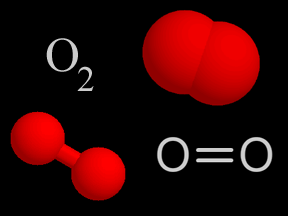This animation shows how a carbon dioxide molecule vibrates when it absorbs heat.
Courtesy of UCAR (LEARN and COMET)
Earth's Greenhouse Gases
Less than 1% of the gases in Earth's
atmosphere
are called
greenhouse gases. Even
though they are not very abundant, these greenhouse gases have a major effect.
Carbon dioxide
(CO2), water vapor (H2O), methane
(CH4), nitrous oxide (N2O), and
a few other gases are greenhouse
gases. They all are molecules
composed of three or more atoms,
bound loosely enough together to be able to vibrate when they absorb heat. Eventually,
the vibrating molecule will emit the radiation again, and it will likely be
absorbed by yet another greenhouse gas molecule. This process is called the
greenhouse effect and keeps heat near the Earth's surface.
Almost all of the other gases in Earth's atmosphere are nitrogen
(N2) and oxygen
(O2). The two atoms in these molecules are bound together
tightly and unable to vibrate, so they do not absorb heat and contribute to
the greenhouse effect.
You might also be interested in:

Less than 1% of the gases in Earth's atmosphere are called greenhouse gases. Even though they are not very abundant, these greenhouse gases have a major effect. Carbon dioxide (CO2), water vapor (H2O),
...more
Carbon dioxide is a colorless and non-flammable gas at normal temperature and pressure. Although much less abundant than nitrogen and oxygen in Earth's atmosphere, carbon dioxide is an important constituent
...more
Methane is gas that is found in small quantities in Earth's atmosphere. Methane is the simplest hydrocarbon, consisting of one carbon atom and four hydrogen atoms. Methane is a powerful greenhouse gas.
...more
Most things around us are made of groups of atoms bonded together into packages called molecules. The atoms in a molecule are held together because they share or exchange electrons. Molecules are made
...more
Nitrogen is a chemical element with an atomic number of 7 (it has seven protons in its nucleus). Molecular nitrogen (N2) is a very common chemical compound in which two nitrogen atoms are tightly bound
...more
Oxygen is a chemical element with an atomic number of 8 (it has eight protons in its nucleus). Oxygen forms a chemical compound (O2) of two atoms which is a colorless gas at normal temperatures and pressures.
...more
Energy from the Sun can enter the atmosphere, but not all of it can easily find its way out again. This is a natural process called the greenhouse effect. Without any greenhouse effect, Earth’s temperature
...more














